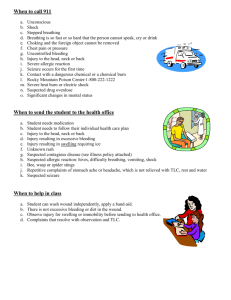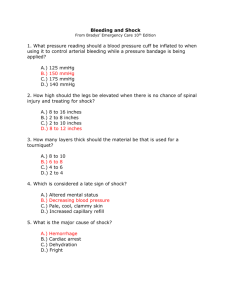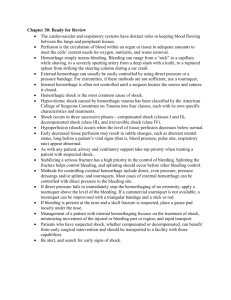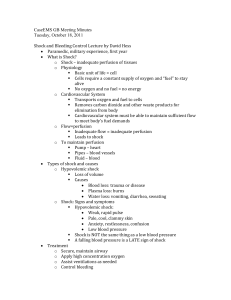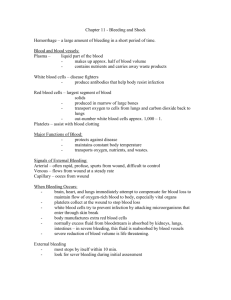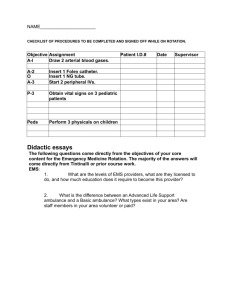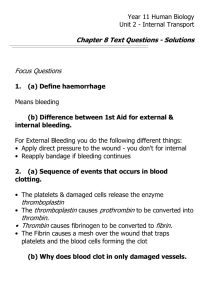Chpt 2-1 Slides Basic Survival Medicine
advertisement
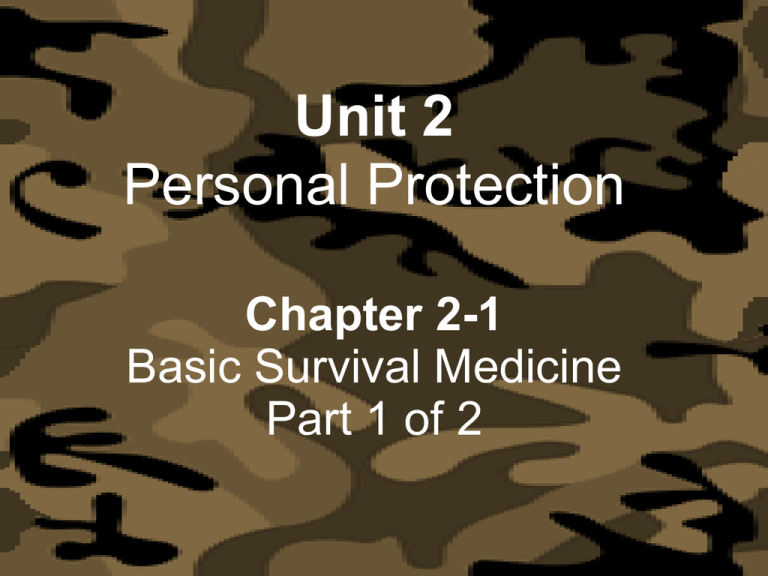
Unit 2 Personal Protection Chapter 2-1 Basic Survival Medicine Part 1 of 2 1. Chapter Objective Know basic survival medicine procedures, treatments, and prevention measures 2. Samples of Behavior/Main Points a. List some of the most frequent injuries. b. Describe the procedures and expedients that survival medicine encompasses. c. State and describe what is essential to prevent infection in a survival situation. d. Describe what reduces the chances of infection from small scratches and abrasions. e. Describe ways a survivor can take a bath when water is in short supply. f. Describe how to care for the mouth and teeth. g. Describe how to care for the feet. h. Describe why rest is important to a survivor. i. List the rules for avoiding illness. 2. Samples of Behavior/Main Points (cont) j. k. l. m. n. o. p. q. r. s. t. u. v. Describe what could cause breathing problems. Define tourniquet. Describe how to control external bleeding. Define gangrene. Define shock Describe how to treat shock Describe some ways to control or limit pain. List and describe two types of fractures. Define dislocations. Describe how to treat skin diseases and ailments. List and describe bites and stings a survivor may encounter List and describe vital injuries. List and describe environmental injuries. 1. Medical Encounters in Survival • You must be very prepared and attentive Most frequent injuries: Simple injuries can become severe and life-threatening within days Infections can kill Cuts, bruises, burns, strains, sprains, dislocations, fractures Cold Survival => frostbite, hypothermia Hot Survival => dehydration, heat cramps, heat exhaustion, heatstroke Survival medicine is more than first aid Cannot rely on medical personnel and equipment Your medical care approaches final treatment You and/or members of your party are the doctor and nurse First Aid Kits Field Dressings Band Aids Duct Tape Moleskin Gauze Medical Tape Antibiotic Ointment Other meds http://dsc.discovery.com/survival/survivaltools/first-aid-kit.html 2. Health Requirements Personal Hygiene Cleanliness is essential to prevent infection Protects against disease germs in your surroundings Protects the group by reducing the spread of germs The principal means of infecting food and open wounds is contact with unclean hands Washing face, hands, and feet reduces chances of infection from scratches and abrasions Soap is not essential to keeping clean (although is helpful) Ashes, sand, and fertile soil may be used to clean the body and cooking utensils If water is in short supply, take an “air bath” or sun bath Keep hair/beard trimmed Hair provides a surface for the attachment of parasites and the growth of bacteria 2. Health Requirements Care of the Mouth and Teeth Use a toothbrush at least once each day When a toothbrush is not available, a “chewing stick” can be made from a twig Stimulate gum tissues by rubbing them vigorously with a clean finger each day Use as much care cleaning dentures and other dental appliances, removable or fixed, as when cleaning natural teeth If you have cavities you can make temporary fillings by placing candle wax, tobacco, aspirin, hot pepper, toothpaste or powder, or portions of ginger root into the cavity 2. Health Requirements Care of the Feet Proper care of the feet is critical in a survival situation If you must travel but you cannot due to foot problems, you may die Feet should be washed, dried thoroughly, and massaged daily If water in short supply, feet should be “air cleaned” Toenails should be trimmed straight across to prevent ingrown toenails Boots should be broken in before wearing them Socks should be large enough to allow the toes to move freely but not so loose that they wrinkle When traveling, feet should be examined regularly for red spots or blisters 2. Health Requirements Clothing and Bedding Clothing and bedding can have disease germs which may be present on the skin, in the stool, in the urine, or in secretion of the nose and throat Outer clothing should be washed with soap and water when it becomes soiled Under clothing and socks should be changed daily Sleeping bags should be turned inside out, fluffed, and aired after each use Bed linen should be changed at least once a week, and the blankets, pillows, and mattresses should be aired and sunned 2. Health Requirements Rest Rest is necessary for the survivor Restores physical and mental energy Promotes healing during an illness or injury If possible, regular rest periods should be planned each day You must learn to become comfortable and to rest under less than ideal conditions Remember the two critical threats to survival: Yielding to comfort Apathy 2. Health Requirements Rules for Avoiding Illness Always purify water obtained from any natural source Pee or poop away from the ground in your camp area Dig “cat-holes” to cover your waste Never put your fingers or infected objects into your mouth Wash hands before handling any food or drinking water All eating utensils should be disinfected after each use To guard against biting insects: Keep body clean Wearing proper protective clothing, head nets, bed nets, etc Use insect repellents Wet clothing should be exchanged for dry clothing as soon as possible to avoid unnecessary body heat loss Do not share personal items Remove and bury all food scraps, cans, and garbage Get adequate sleep (7-8 hours) each day 3. Medical Emergencies Breathing Problems – Main Causes Foreign matter in mouth or throat that blocks opening to trachea Face or neck injuries Inflammation and swelling of mouth and throat caused by inhaling smoke, flames, and irritating vapors or by an allergic reaction “Kink” in the throat (caused by the neck bent forward so that the chin rests upon the chest) may block the passage of air Tongue blocks passage of air to the lungs upon unconsciousness 3. Medical Emergencies Severe Bleeding Extremely dangerous Loss of 1 liter of blood => moderate shock Loss of 2 liters of blood => severe shock => life threatening Loss of 3 liters of blood => usually fatal Control Bleeding In survival situation, you must control serious bleeding immediately Replacement fluids normally not available Victim can die within a matter of minutes The tourniquet, when required and properly used, will save life But if used improperly, it may cause detah Quick Clot 3. Medical Emergencies External Bleeding Arterial => Arteries carry blood away from heart and through body A cut artery issues bright red blood from the wound in distinct spurts or pulses that correspond to the heartbeat Arterial bleeding is the most serious type of bleeding If not controlled promptly, it can be fatal Venous => Venous blood returns to the heart through blood vessels called veins Blood is dark red, maroon, or bluish Venous bleeding usually easier to control than arterial bleeding Capillary => Extremely small vessels that connect the arteries with the veins Most commonly occurs in minor cuts and scrapes 3. Medical Emergencies Methods to Control External Bleeding Direct Pressure Elevation Pressure Points Digital Legation Tourniquet • If blood loss is significant, treat for shock Keep patient warm Elevate the feet 8 to 10 inches Control the bleeding Transport ASAP 3. Medical Emergencies Methods to Control External Bleeding Direct Pressure Most effective way for venous bleeding; 1st option for arterial bleeds Apply pressure directly over the wound using a dressing If dressing shows blood seepage; don’t remove the dressing—instead add another layer of dressing/gauze over it and find a pressure point For arterial bleed, if direct pressure doesn’t work, then use tourniquet Elevation Raise injured limb (arm or leg) as high as possible above heart level Slows blood loss by aiding the return of blood to the heart and lowering the blood pressure at the wound Pressure Points A location where the main artery to wound lies near surface of the skin Digital Ligation Applying pressure with a finger or two on bleeding end of the vein or artery 3. Medical Emergencies Methods to Control External Bleeding (continued) Tourniquet Use a tourniquet only when direct pressure and all other methods did not control the bleeding If you leave a tourniquet in place too long (more than several hours), the damage to the tissues can progress to gangrene and a loss of the limb Rules for placing the tourniquet: Make sure the tourniquet is at least 2 to 4 inches wide (do not use shoe strings, wire, etc) Proximal to the wound (around the limb) and between the wound and the heart 5 to 10 centimeters above the wound Tighten until bleeding stops If patient is unconscious, write the time the tourniquet was applied on the patient’s forehead Make sure the tourniquet is visible to EMS responders 3. Medical Emergencies Shock An intense stress reaction and clinical condition characterized by symptoms that arise when cardiac output is not enough to fill the arteries with blood under enough pressure to provide an adequate blood supply to the organs and tissues A circulatory reaction of the body (as a whole) to injury Initially favors body resistance to the injury by ensuring adequate blood supply to vital structures But may progress to the point of circulatory failure and death Signs and symptoms of shock Rapid shallow breathing Cold, clammy skin Rapid, weak pulse Dizziness, fainting Weakness Eyes appear to stare Anxiety or agitation Seizures Confusion or unresponsiveness Low or no urine output Bluish lips and fingernails Sweating Chest pain 3. Medical Emergencies Shock (continued) Fluids Generally prohibited in the treatment of shock Poorly absorbed when given by mouth May interfere with follow-on anesthesia for surgery Survivors cannot be denied water for long periods Their recovery depends upon adequate hydration 3. Medical Emergencies Shock - Preventing and Treating Shock The Basics: • • • • Keep patient warm Elevate the feet 8 to 10 inches Control the bleeding Transport ASAP 3. Medical Emergencies Shock - Preventing and Treating Shock • More General Treatment Info: If the victim is conscious, place on a level surface and elevate feet/legs If the victim is unconscious, place on his side or abdomen with head turned to one side to prevent choking If wet, remove wet clothing and replace with dry clothing Maintain body heat by insulating the victim from the surroundings and, in some instances, applying external heat Use warm liquids/foods or pre-warmed sleeping bag/blanket to provide external warmth Improvise a shelter If the victim is conscious, slowly administer small doses of a warm salt or sugar solution, if available If victim is unconscious or has abdominal wounds, do not give fluids by mouth Have the victim rest for at least 24 hours If you are alone, lie in a hole in the ground, behind a tree, or any other place out of the weather, with your head lower than your feet If you are with a buddy, check your patient constantly 4. Pain • Control of pain • • • • • Both difficult and essential Pain adds to discomfort It can contribute to shock Makes survivor more vulnerable Ideally, pain should be eliminated by the removal of the cause • Position, Heat, and Cold • • • • • Part of body that is hurting should be put at rest, or restricted Applying warmth reduces pain, for example a toothache In some conditions, applying cold has the same effect, for example a sprain Warmth or cold is best applied by using water due to its high specific heat Try both to determine which is most beneficial • Pain Killers • Pain killers, Aspirin, Ibuprofen, etc are primarily intended to combat the discomforts of colds and upper respiratory diseases, and, at best, will just take the edge off severe pain • Some parts of vegetation can be used (e.g., willows; wintergreen, boiled bark of magnolia tree)


